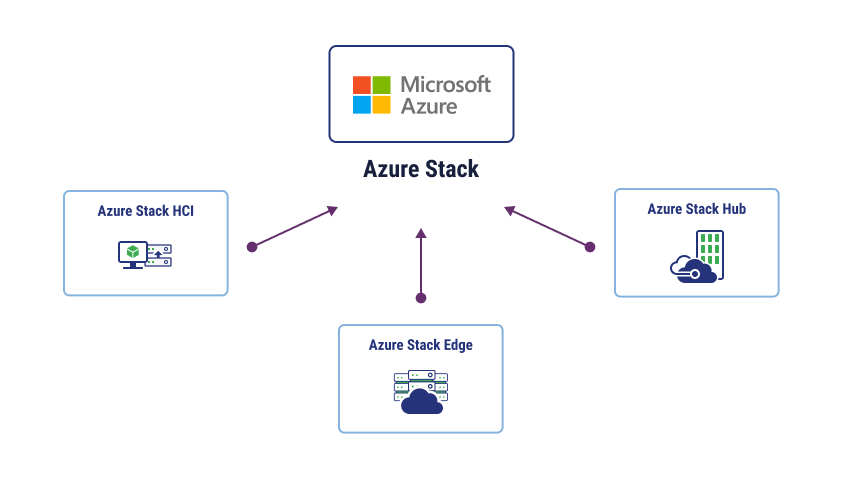
Do you feel constrained by your on-premises environment? Is the public cloud not quite giving you the control you need over your workloads? Microsoft Azure Stack could be the compromise you need, incorporating Azure public cloud into your existing setup as part of a hybrid cloud strategy. We’ll talk about how you can use Azure Stack, what options are available, and the benefits businesses can enjoy after making the switch.
What Exactly is Microsoft Azure Stack?
Microsoft Azure Stack includes several products organizations can use to extend Azure to their own environment, which could be an on-premises data center, a third-party managed services provider like TierPoint, an edge location, or a remote office. Instead of being limited to public cloud, Azure Stack expands Azure capabilities to fit hybrid cloud applications.
How is Azure Stack Different from Azure?
Microsoft Azure Stack is different from Microsoft Azure based on its deployment, scalability, support, and services. While Azure is a public cloud platform managed by Microsoft, Azure Stack is an extension of Azure that is deployed on-premises or in a local data center, giving organizations more control over their infrastructure.
In both Azure and Azure Stack, customers manage resource scalability, but with key differences. Azure provides automated scaling tools and managed services, requiring customer configuration and monitoring. Azure Stack, however, demands organizations handle scaling and updates on their own infrastructure, offering greater control at the cost of increased management effort.
For Azure, support is fully provided by Microsoft because it’s included within their public cloud offering. With Azure Stack, Microsoft supports the Azure services, but organizations are responsible for managing the hardware and local infrastructure. This includes handling issues related to physical hardware and on-premises integration, potentially with help from certified partners or hardware vendors.
Additionally, while Azure Stack provides a subset of Azure services, it includes many of the core services and capabilities of Azure, such as virtual machines, storage, and networking. However, not all Azure services are available on Azure Stack, and organizations may need to evaluate which services they require and whether they are supported on Azure Stack.
An Overview of Azure Stack Offerings
Azure Stack offers a portfolio of products that extend Azure native services and capabilities to on-premises or edge locations.

Azure Stack HCI
Azure Stack HCl is perfect for businesses looking to modernize their aging infrastructure. The hyper-converged solution combines compute, storage, and virtualization resources to help businesses update their systems efficiently.
Azure Stack HCI is suitable for high-performance workloads, supporting remote branch offices, and extending on-premises environments. This software solution runs on a cluster of servers and is tightly integrated with Azure, making tasks like scalability, disaster recovery, backup, and running Azure services straightforward.
Azure Stack Edge
Businesses that use edge computing to support Internet of Things (IoT) devices, machine learning, or real-time processing can use Azure Stack Edge to run their workloads at edge locations. This solution allows organizations to run workloads at edge locations, bringing processing power closer to the data. By doing so, it enables lower latency, faster analysis, and more efficient decision-making.
Azure Stack Edge is a physical appliance pre-configured by Microsoft that can be deployed at edge locations and managed through Azure. Think of it as a contained onsite Azure data center. These devices are built to run AI and machine learning models directly at the edge, ensuring that critical processing happens close to where the data is generated.
Azure Stack Hub
The complete cloud experience on-premises is made possible with Azure Stack Hub. Organizations can keep their data and applications onsite while enjoying a set of cloud services similar to public Azure. This can run in a connected mode where the private cloud interacts with public Azure, or in disconnected mode to meet strict data residency requirements or operated on limited connectivity.
Leveraging Azure Stack for True Hybrid Benefits
By leveraging Azure Stack, your business can connect your on-premises infrastructure with public cloud. This hybrid cloud approach comes with a number of benefits, including improved security, more integrations, greater flexibility, and enhanced performance.

Hybrid Integrations and Consistency
Azure Stack seamlessly integrates with the public Azure cloud, allowing for smooth migration and orchestration of workloads between on-premises and cloud environments. With consistent tools, APIs, and languages available across both public and private clouds, development and application management become a more streamlined process. Azure Arc extends these capabilities, enabling centralized management of resources across hybrid and multicloud environments through a single pane of glass, enhancing governance and consistency.
Flexibility and Control
Azure Stack provides organizations with significant flexibility and control, enabling seamless integration of private and public cloud environments. This combination allows teams to dynamically adjust resources based on workload demands while retaining authority over their infrastructure. Organizations can customize resource management, allocation, and security settings, leading to enhanced cost optimization and improved data protection. The ability to leverage both environments strategically empowers organizations to respond quickly to changing business needs while maintaining compliance and governance.
Scalability
Both Azure Stack and public cloud environments provide excellent scalability. Azure Stack enables easier resource scaling compared to legacy on-premises solutions; however, it is still limited by the underlying hardware and infrastructure capacity. Organizations must carefully plan their configurations to ensure they can meet future scalability needs.
Improved Security
A hybrid solution utilizing Azure Stack can enhance security through built-in redundancies and failback mechanisms. This architecture offers multiple layers of protection, allowing for robust backup and disaster recovery options. By integrating on-premises and public cloud resources, organizations can implement comprehensive security policies and protocols tailored to their specific needs, ensuring better data protection and compliance across environments.
Reduced Latency and Enhanced Performance
If you’re looking for greater performance and lower latency in edge deployments, Azure Stack Edge enhances real-time responsiveness. Similarly, Azure Stack HCI has strong processing capabilities for latency-sensitive workloads.
Compliance and Regulatory Support
As mentioned, Azure Stack can help businesses meet data residency requirements by keeping data and applications on-premises, while still allowing for the benefits and tools that come with Azure.
Use Cases for Azure Stack
Different Azure Stack solutions can be used to solve different problems for businesses, whether it’s facilitating edge computing, modernizing infrastructure, or supporting high-performance workloads. Here are a few examples of what Azure Stack can do for your business:
- Modernize applications before migrating entirely to the public cloud with Azure Stack Hub
- Use real-time data to optimize production processes
- Manage and pre-process data from IoT devices
- Transfer data from edge devices to the cloud for storage, data analysis, or further integration
- As needs grow, use Azure Stack HCI to add more servers to the cluster
- Run local applications and desktops at remote branch offices
- Run demanding, high-performance workloads via Azure Stack HCI
- Use Azure Stack Hub in disconnected mode to meet compliance regulations and restrict data transfer to the public cloud
- Locally identify equipment failures with Azure Stack Edge
Ready to Incorporate Azure Stack into Your IT Systems?
Developed in collaboration with Microsoft, Dell’s APEX Cloud Platform stands out as the premier solution for extending and optimizing Azure hybrid cloud within TierPoint data centers. Integrating Azure Stack into your IT infrastructure can greatly enhance your hybrid cloud strategy by seamlessly connecting your systems with Azure’s public cloud services. Utilizing Azure Arc, you can achieve versatile hybrid cloud capabilities, ensuring consistent management and optimization across your entire Azure environment.
Relying on TierPoint experts for the integration of software and hardware guarantees a smooth transition, enabling businesses to fully harness the transformative potential of this hybrid cloud solution. Moreover, incorporating Azure Stack provides a unified development environment, streamlined operations, and enhanced scalability. Need help optimizing your hybrid cloud strategy with Azure Stack? Contact TierPoint today to learn how our Managed Azure Stack services can help you achieve seamless integration and enhanced performance.
Looking to understand recent VMware changes and how it impacts your cloud transformation? Navigate cloud transformation with confidence by partnering with TierPoint, your trusted expert in VMware changes and cloud migrations. Our certified professionals offer unbiased guidance across major cloud ecosystems, including Azure Stack, Azure Native, VMware and Azure VMware Solution, and AWS, ensuring a seamless transition tailored to your unique business needs.
From comprehensive assessments to customized migration plans and 24/7 managed services, we help you optimize performance, manage costs, and unlock innovative capabilities like AI and machine learning. Don’t let uncertainty hold you back – schedule a strategic cloud consultation with TierPoint today and chart the optimal path for your business’s future in the cloud.

